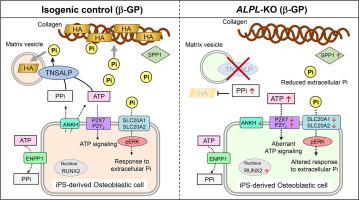磷酸生成受损和细胞外ATP信号异常在低磷酸症发病机制中的参与:alpl敲除人iPS细胞模型的分析
IF 3.6
2区 医学
Q2 ENDOCRINOLOGY & METABOLISM
引用次数: 0
摘要
低磷酸症(HPP)是由编码组织非特异性碱性磷酸酶(TNSALP)的基因ALPL的失活变体引起的。为了加深我们对HPP致病机制的理解,我们在此通过对健康受试者的iPS克隆应用CRISPR/ cas9介导的基因缺失,产生了alpl敲除(KO)的人诱导多能干细胞(iPS)。我们分析了两个ALPL-KO克隆,一个ALPL-异源KO克隆和一个除ALPL外等基因的对照克隆。在使用β-甘油磷酸酯(通过tnsalp介导的降解产生无机磷酸盐(Pi))的成骨培养中,ALPL-KO克隆显示矿化受损,细胞外焦磷酸盐(PPi)水平升高,细胞外Pi水平降低。用3 mM Pi代替β-甘油磷酸酯进行成骨诱导,可以挽救ALPL-KO细胞中羟基磷灰石含量的降低,尽管细胞外PPi水平仍然很高;但羟基磷灰石分布异常。从ALPL-KO iPS克隆分化的成骨细胞系细胞在β-甘油磷酸酯培养基中显示SPP1上调,ANKH和III型钠/磷酸盐共转运蛋白基因下调,而在3 mM Pi培养基中则无此现象。在两种培养条件下,来自ALPL-KO iPS克隆的成骨细胞系细胞的细胞外ATP水平均升高,这与编码嘌呤能受体的P2X7的下调有关。此外,在β-甘油磷酸酯的培养下,从ALPL-KO iPS克隆分化的成骨细胞谱系细胞对细胞外Pi的反应发生了变化。这些结果表明,局部细胞外Pi生成的减少和ATP信号的异常在HPP的发病机制中发挥了重要作用。本文章由计算机程序翻译,如有差异,请以英文原文为准。

Involvement of impaired phosphate production and aberrant extracellular ATP signaling in the pathogenesis of hypophosphatasia: Analysis of ALPL-Knockout human iPS cell models
Hypophosphatasia (HPP) is caused by inactivating variants of ALPL, the gene encoding tissue non-specific alkaline phosphatase (TNSALP). In order to deepen our understanding of the pathogenic mechanisms of HPP, we herein generated ALPL-knockout (KO) human induced pluripotent stem (iPS) cells by applying CRISPR/Cas9-mediated gene deletion to an iPS clone derived from a healthy subject. We analyzed two ALPL-KO clones, one ALPL-hetero KO clone, and a control clone isogenic except for ALPL. In an osteogenic culture using β-glycerophosphate, which generates inorganic phosphate (Pi) by TNSALP-mediated degradation, ALPL-KO clones showed impaired mineralization, elevated levels of extracellular pyrophosphate (PPi), and reduced levels of extracellular Pi. Osteogenic induction using 3 mM Pi instead of β-glycerophosphate rescued the decreased content of hydroxyapatite in ALPL-KO cells despite the still high levels of extracellular PPi; however, abnormal distribution of hydroxyapatite was noted. Osteoblast lineage cells differentiated from ALPL-KO iPS clones showed the up-regulation of SPP1 and the down-regulation of ANKH and the genes for type III sodium/phosphate co-transporters in the culture using β-glycerophosphate, but not when 3 mM Pi was used. Extracellular ATP levels were elevated in osteoblast lineage cells derived from ALPL-KO iPS clones in both culture conditions, which was associated with the down-regulation of P2X7 encoding a purinergic receptor. Moreover, osteoblast lineage cells differentiated from ALPL-KO iPS clones in the culture using β-glycerophosphate showed a change in cellular response to extracellular Pi. These results suggest that the reduced local production of extracellular Pi and aberrant ATP signaling play substantial roles in the pathogenesis of HPP.
求助全文
通过发布文献求助,成功后即可免费获取论文全文。
去求助
来源期刊

Bone
医学-内分泌学与代谢
CiteScore
8.90
自引率
4.90%
发文量
264
审稿时长
30 days
期刊介绍:
BONE is an interdisciplinary forum for the rapid publication of original articles and reviews on basic, translational, and clinical aspects of bone and mineral metabolism. The Journal also encourages submissions related to interactions of bone with other organ systems, including cartilage, endocrine, muscle, fat, neural, vascular, gastrointestinal, hematopoietic, and immune systems. Particular attention is placed on the application of experimental studies to clinical practice.
 求助内容:
求助内容: 应助结果提醒方式:
应助结果提醒方式:


